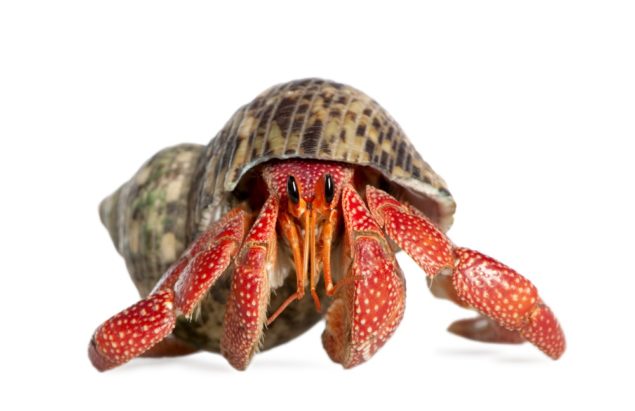Learn all about hermit crabs care, shells, food, habitat and molting. Hermit crabs are decapod crustaceans of the superfamily Paguroidea. There are more than 500 different species of hermit crab found in marine habitats all around the world. Although hermit crabs do venture into deeper waters, they are more commonly found in coastal waters where there is more food and places to hide.
A hermit crabs shell is more than his house; it protects his soft abdomen and helps him maintain a proper humidity level. It’s a big deal if a crab decides to give up his shell. Often it’s because he’s decided to trade shells, but sometimes a crab will have more serious reasons to abandon his home.
Hermit crabs can live up to 10 years. They can grow up to 6 inches long. Hermit crabs can be handled, but will pinch if threatened or scared. They molt (shed their skin) and change shells as they grow.
In the wild, land hermit crabs are omnivores, meaning they eat both plant and animal matter. In captivity, their diet should be based on a balanced commercial food supplemented with a variety of fresh foods and treats. Hermit crabs can live long lives if kept in a proper home. Their habitat should have everything they need to survive and thrive. By providing the correct tank, substrate, decor, sources of food and water, and proper humidity your pets can keep you entertained for years.
Molting is the process by which a hermit crab grows. It involves shedding of the exoskeleton and for a short time afterward the crab is unable to move until it regains muscle control and the new exoskeleton hardens up. At this point the crab will begin eating the old exoskeleton which helps to recycle calcium and other minerals necessary for the new exoskeletons health and rigidity. Because hermit crabs are vulnerable during this time they need protection, insulation and darkness necessary to allow the molting hormone (MH) to be secreted so that the shedding process known as ecdysis can begin.
What is Hermit crab?
Hermit crab is a small sized crustacean. Hermit crab has a soft under-body which it protects by carrying a shell on its back. Crab has a soft abdomen so it hides in a shell. There are two types of hermit crabs: marine and land hermit crabs. Marine crabs live in the ocean and most kinds of hermit crabs are marine. Some of these can be kept in a reef tank. Land hermit crabs are special because they are able to live on land. There are only a few species that can do this. They are nocturnal (not sure if marine crabs are too) and are scavengers that eat a variety of food from seaweed to dead animals. They breed by laying eggs in the ocean, where the little crabs will live for a long time before they become full hermit crabs.
Hermit crab Care
Hermit crabs are social animals and should have at least two other crabs with them. The proper home for your crabs should be one that holds in humidity, but still lets in fresh air. A fish tank or reptile aquarium usually does nicely. Acrylic terrariums tend to work better, as they hold the humidity and heat more efficiently. You should buy a hygrometer (humidity gauge). These will help you to monitor and maintain a 75-85% relative humidity. Hermit crabs breathe through (hardened) gills, and can’t breathe properly unless the air is humid enough. The ideal range is at least 75% relative humidity. Humidity lower than 70% will cause suffocation, which kills slowly over several weeks or months and is extremely painful Hermit crabs are tropical animals and do best in warm temperatures. 75-85°F is the temperature range.
Hermit crab Shells
Hermit crab shell is not its own, but one that belonged to another animal. As hermit crabs grow, they continue to find larger shells to accommodate their increasing size. Selecting hermit crab shells by the opening size makes it easy to choose the right ones.
Hermit crab Food
Pretty much any fruit (fresh or dried) can be offered, although some experts recommend avoiding highly acidic or citrus foods (e.g. oranges, tomatoes). Try a variety of vegetables but avoid starchy vegetables such as potatoes and stay away from iceberg lettuce as it is of very low nutritional value. Crabs may really like salty, fatty, or sugary snacks such as pretzels, chips, and sweetened cereal but these should be avoided. Also, avoid feeding dairy products. If you want to avoid baby food and use fresh fruits and vegetables, try blueberries, mango, banana, pineapple, grapes, sweet potatoes, carrots, corn, spinach, apple and broccoli heads. Walnuts, peanut butter, fresh rose or sunflower petals, honey, oatmeal and wheat germ offer a nice change to fruits and vegetables. Sardines, blood worms and meal worms are appealing, as is the meat you eat. If you give Sheldon meat, make sure it’s not seasoned with any spices or table salt.
Hermit crab Habitat
A crabitat is where your hermit crabs will spend most of their time, so choose a bad for the crabs and can cause unhealthy bacteria to bloom in their habitat. Although hermit crabs do venture into deeper waters, they are more commonly found in coastal waters where there is more food and places to hide.
Hermit crab Molting
Hermit crab molting signs that a hermit crab gives its owner before it needs to molt (shed its skin). Hermit crabs molt on a regular basis as they grow but it is surprisingly easy to mistake a molting hermit crab for a dead hermit crab. A molting crab appears quite limp and lifeless and the body is often partway out of the shell. Sometimes, with very careful observation, you will be able to see small twitches from the hermit crab’s body while it is molting, but otherwise it can be very difficult to tell whether or not it is still alive.



